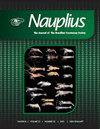Podding of Paralomis granulosa (Lithodidae) juveniles inhabiting kelp forests of the Cape Horn Archipelago (Chile)
IF 0.8
4区 生物学
Q4 MARINE & FRESHWATER BIOLOGY
引用次数: 2
Abstract
Abstract Subtidal observations along the Cape Horn Archipelago, Chile (CHA) in February 2017 revealed an unusually large aggregation (or pod) of juvenile false king crabs, Paralomis granulosa (Hombron and Jacquinot, 1846), in association with kelp forests (Macrocystis pyrifera and Lessonia spp.). This is the first study to report a dense aggregation of juveniles of this crab, which was observed at Wollaston Island (WI) (~ 10 m). Paralomis granulosa was present on half the transects at WI (N=10), with a density of 3.1 ± 9.9 ind. m-2. Photographs from the podding event showed densities of P. granulosa ranging from 63 to 367 ind. plant-1 (190 ± 133 ind. plant-1). Juveniles (32.8 ± 7.3 mm carapace length) were recorded on kelp fronds, holdfasts, kelp stipes, and adjacent rocky bottom of this protected coast. This podding behavior resembles that of other juvenile king crabs in terms of homogeneity in size structure and may be a predator avoidance mechanism. These observations highlight three aspects of this kelp-animal relationship: (i) identification of a previously unknown ecosystem service provided by sub-Antarctic kelp forests to the associated benthic fauna; (ii) the ecological value of kelp as a bioengineering species; and (iii) pods being an important attribute for population assessments. Due to the importance of the CHA in the life cycle for this and other species, we suggest the archipelago be incorporated within the recently established Diego Ramirez Island-Drake Passage Marine Park.居住在合恩角群岛(智利)海带林中的细粒棘蝗(石蝗科)幼体的荚果
2017年2月在智利合合角群岛(CHA)进行的潮下观测发现,在海带森林(Macrocystis pyrifera和Lessonia spp.)附近,有一个异常大的假王蟹幼蟹群(paromis granulosa, Hombron and Jacquinot, 1846)。本研究首次报道了在沃拉斯顿岛(WI) (~ 10 m)观察到该蟹幼蟹密集聚集的情况,在WI (N=10)的一半样带上发现了颗粒状蟹,密度为3.1±9.9 ind.m -2。荚果事件的照片显示,颗粒假单胞菌的密度为63 ~ 367个(190±133个)个。在受保护海岸的海带叶、海带支架、海带茎和邻近的岩石底部记录到幼鱼(32.8±7.3 mm)的甲壳长度。这种结荚行为与其他幼年帝王蟹在大小结构上的同质性相似,可能是一种躲避捕食者的机制。这些观察结果突出了这种海带与动物关系的三个方面:(i)确定了亚南极海带森林为相关底栖动物提供的以前未知的生态系统服务;(ii)海带作为生物工程物种的生态价值;(3)豆荚是种群评估的重要属性。由于CHA在这个物种和其他物种的生命周期中的重要性,我们建议将群岛纳入最近建立的迭戈拉米雷斯岛-德雷克通道海洋公园。
本文章由计算机程序翻译,如有差异,请以英文原文为准。
求助全文
约1分钟内获得全文
求助全文

 求助内容:
求助内容: 应助结果提醒方式:
应助结果提醒方式:


